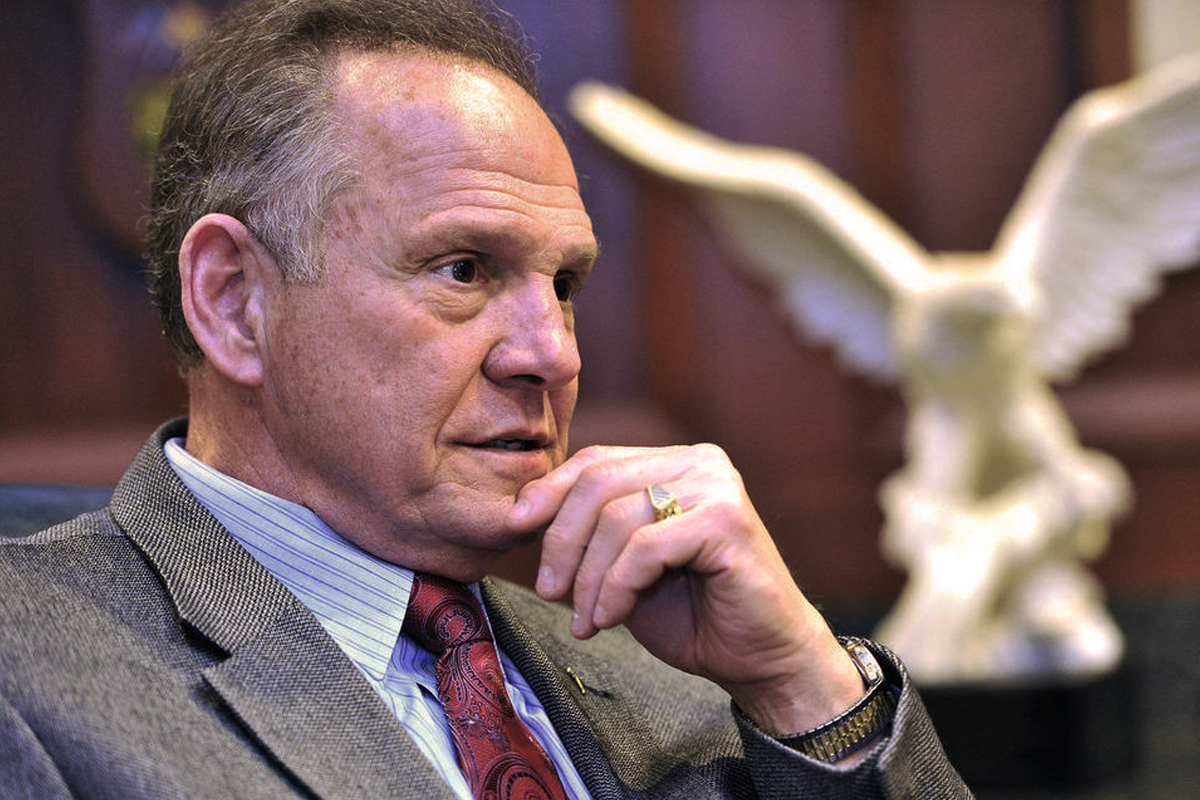The World Turned Upside Down: Reality on Trial with Alabama’s Chief Justice
If buttercups buzzed after the bee
If boats were on land, churches on sea
If ponies rode men and if grass ate the cows
And cats should be chased into holes by the mouse . . .
If summer were spring, and the other way ‘round
Then all the world would be upside down!—from the English ballad, “The World Turned Upside Down”
Woe unto them that call evil good, and good evil; that put darkness for light, and light for darkness; that put bitter for sweet, and sweet for bitter!
—Isaiah 5:20
Falsehood isn’t truth. Good is not evil. And men who courageously defend the rule of law should not be branded as lawless fiends.
But if Alabama’s Judicial Inquiry Commission (JIC) has its way, the Court of the Judiciary (COJ) — and a gullible, uninformed public — will embrace the opposite view as Chief Justice Roy S. Moore of the Supreme Court of Alabama stands trial this coming Wednesday in Montgomery.
This is not just any legal ethics case. At stake is not only the future of the Chief’s status on the bench — as he faces potential censure and further suspension with or without pay from his post on the Alabama Supreme Court — but a right understanding of what a judge’s role is, as well as a right view of how the U.S. Constitution should be understood, defended, and applied.
Stepping back, yet another critical point stands out: whether marriage will be defined, according to God’s Word, as between a man and a woman, or if the legal fiction of “same-sex marriage” will replace it and be sanctioned as legitimate.
The Road to the Trial: Marriage under Fire by the Federal Courts
It all started on January 24, 2015, when Judge Callie Granade, Federal District Judge in the Southern District of Alabama, ruled that the gender requirement for marriage in Alabama was null in the entire state — thus purporting to legalize same-sex marriage.1
Enter Chief Justice Moore. On February 8, 2015, two weeks after Granade’s decision, he entered an administrative order prohibiting any probate judge in Alabama from issuing or recognizing a marriage license which violates Alabama’s Marriage Amendment or Marriage Act.2
The Alabama Policy Institute (API) sought separate relief before the full court in an Emergency Petition, and on March 3, the Alabama Supreme Court intervened, ordering four probate judges to comply with Alabama’s marriage law, rather than Judge Granade’s decision. After noting that the Alabama code expressly states that “[m]arriage is inherently a unique relationship between a man and a woman” and that “[n]o marriage license shall be issued in the State of Alabama to parties of the same sex,” and further pointing out that a key amendment to the Alabama Constitution contains identical language, the court went on to state:
“[B]y history and tradition,” and one should add, by the text of the Constitution, “the definition and regulation of marriage has been treated as being within the authority and realm of the separate States.” . . . That fact does not change simply because the new definition of marriage has gained ascendancy in certain quarters of the country, even if one of those quarters is the federal judiciary.
As it has done for approximately two centuries, Alabama law allows for “marriage” between only one man and one woman. Alabama probate judges have a ministerial duty not to issue any marriage license contrary to this law. Nothing in the United States Constitution alters or overrides this duty.3
Nine days later, the Alabama Supreme Court issued a follow-up ruling, expanding this directive to all probate judges in the state. Chief Justice Moore abstained from voting in both of these decisions “to avoid the appearance of impropriety” due to the previous administrative order as well as a memorandum he had issued pursuant to this case.4
Then came Obergefell v. Hodges. On June 26, 2015, the Supreme Court of the United States issued a 5-4 decision in a case from the Sixth Circuit, declaring “same-sex marriage” to be a new fundamental right, and directing the states of Kentucky, Michigan, Ohio, and Tennessee to remove the gender requirement from their marriage laws.5 In response, the Alabama Supreme Court asked the parties in the API case to submit new briefs to address how Obergefell might affect the “existing orders” they had issued in March.6
The Court’s Foot-Dragging, a Temporary Order by the Chief
Upon receiving these briefs, the court, as a body, drug their feet in ruling on what legal impact the U.S. Supreme Court’s decision did or did not have on Alabama’s marriage laws. Months passed, with no decision forthcoming. Meanwhile, the debate across America raged on what the implications of Obergefell were to state laws concerning marriage. The issue reached a boiling point when Kentucky County Clerk Kim Davis was jailed on September 3 for refusing to issue marriage licenses to same-sex couples.
Davis’s jailing sparked new concerted appeals from Alabama probate judges to the state Supreme Court to rule on the effect of Obergefell in API, with Washington County Probate Judge Nick Williams and Elmore County Probate Judge John Enslen filing separate Emergency Petitions in September and October. Also in October, the American College of Pediatricians and the CEC for Life filed two briefs, urging the Alabama Supreme to promptly rule on API.7
“Where Is the Supreme Court of Alabama?” questioned Dr. John Killian and Eunie Smith in an Op-Ed on Al.com — echoing what was on the minds of millions of Alabamians — but the state’s chief judicial body remained irresponsibly silent.8
With the API case still pending, Chief Justice Moore sought to temporarily clear the air on January 6, 2016, with a factual 4-page Administrative Order to Alabama’s probate judges. The Chief wisely acknowledged that he did not have the authority to issue a unilateral decision in API, even as he sought to bring some needed clarity to where things stood:
I am not at liberty to provide any guidance to Alabama probate judges on the effect of Obergefell on existing orders of the Alabama Supreme Court [in API]. That issue remains before the entire Court which continues to deliberate on the matter. . . .
Yet the fact remains that the administration of justice in the State of Alabama has been adversely affected by the apparent conflict between the decision of the Alabama Supreme Court in API and the decision of the United States Supreme Court in Obergefell.
NOW THEREFORE,
As Administrative Head of the Unified Judicial System of Alabama, authorized and empowered pursuant to Section 12-2-30(b)(7), Ala. Code 1975, to ‘take affirmative and appropriate action to correct or alleviate any condition or situation adversely affecting the administration of justice within the state,’ and under Section 12-2-30(b)(8), Ala. Code 1975, to “take any such other, further or additional action as may be necessary for the orderly administration of justice within the state, whether or not enumerated in this section or elsewhere”; And in that “an order issued by a court with jurisdiction over the subject matter and person must be obeyed by the parties until it is reversed by orderly and proper proceedings.” United States v. Mine Workers, 330 U.S. 258, 293(1947). . . .
IT IS ORDERED AND DIRECTED THAT:
Until further decision by the Alabama Supreme Court, the existing orders of the Alabama Supreme Court that Alabama probate judges have a ministerial duty not to issue any
marriage license contrary to the Alabama Sanctity of Marriage Amendment or the Alabama Marriage Protection Act remain in full force and effect.9
The Left Unhinged: False Accusations Lodged against Chief Justice Moore
Predictably, radical left-wingers and liberal activists came unglued when they learned of Chief Justice Moore’s Administrative Order, accusing him of defying the “law,” and they submitted complaints to the Judicial Inquiry Commission (JIC), alleging ethical misconduct on the part of the Chief.10
Yet a plain reading of the Chief Justice Moore’s order of January 6, 2016 makes it clear that he was no renegade judge seeking to flaunt his views outside the bounds of his lawful jurisdiction. He was a man doing his duty in the midst of a contentious controversy. The Chief’s legal counsel offered this helpful corrective to the false narrative being espoused by Moore’s opponents, including the JIC, which filed six charges against him with the Court of the Judiciary (COJ) on May 6:
The “plain and unambiguous” language of the [Administrative] Order states that the Chief Justice is not intruding on the authority of the Alabama Supreme Court to interpret, modify, or vacate its own orders [in API]. As the Chief Justice concluded on page 4, until the Alabama Supreme Court acts, those orders remain yet in effect. The Chief Justice made it unequivocally clear that he had no authority to affirm or reject those orders, a matter that lay in the hands of the entire Court. . . .
The Chief Justice highlighted the phrase “existing orders” because those are the exact words used in the Supreme Court’s order of June 29, 2015 to describe the March orders. In the Court’s June 29 order . . . the Supreme Court invited the parties in API to address the “effect of the Supreme Court’s decision [in Obergefell] on this Court’s existing orders in this case.” (Emphasis added.) The statement that the March 2015 API orders continued to exist post-Obergefell was a pronouncement, not of the Chief Justice, but of the Alabama Supreme Court. Does the JIC now intend to prosecute the entire Court, or does it limit its misuse of power to targeting the Chief Justice for quoting what the Court itself said?11
But rather than dismiss the JIC’s fallacious charges, the Court of the Judiciary has opted for a full-blown trial of Chief Justice Moore, scheduled to take place this Wednesday at 9 a.m. (CDT) in Montgomery. What makes this proceeding even more ludicrous is the fact that the Chief’s temporary Administrative Order of January 6 expired on March 4 when the Alabama Supreme Court finally ruled as a body on the implications of Obergefell on API in a 9-0 decision.12
While the March 2016 ruling could have been far stronger on the whole, it nonetheless upheld the orders the court made in API the previous March — the very orders that Chief Justice Moore reminded Alabama’s probate judges in his Administrative Order were still in place, unless vacated. Vacated they were not when he issued his January 6 statement, and neither are they now, as the Court upheld them in their March 2016 ruling, rendering the Chief’s January 6 statement now irrelevant.
Selective Assent to Reality: Uncompromising Christians Are Not to be Countenanced
Marriage between one man and one woman still remains the law in Alabama. Even those who oppose this reality agree that this is where matters now stand.
The ACLU, hardly a friend to a Christian moral order, stated on March 25 that “the Alabama Supreme Court has acted in a manner that leaves in place its earlier order to Alabama’s probate court judges to follow Alabama law with regard to its prohibition of same-sex marriage, notwithstanding Obergefell.”13
More significantly, Federal Judge Callie Granade of the Southern District of Alabama — whose January 25, 2015 ruling against traditional marriage set in motion many of the events of the last year and half pertaining to Alabama’s marriage controversy — agreed with this conclusion on July 7, 2016: “the Alabama Supreme Court [in API] did not vacate or set aside its earlier . . . [ruling] directing Alabama’s probate judges to comply with the Alabama [marriage] laws.”14
If enemies of morality are willing to concede to intellectual honesty when it comes to the recent results of the API case in Alabama, though they may loathe its conclusion, why are parties of this ilk going out of their way to misrepresent Chief Justice Moore’s actions and to toss him off of the bench?
While we must be careful not to over-generalize, it is fair to suggest that the Chief’s uncompromising Christian witness and unwillingness to shirk his constitutional duties play a major role in the matter. These virtues that cause cowards and foes alike to cringe were abundantly on display in the Chief’s hard-hitting concurrence in the court’s 9-0 ruling in March of this year. Here are a few of many powerful excerpts he wrote as part of this decision:
- I agree with the Chief Justice of the United States Supreme Court, John Roberts, and with Associate Justices Antonin Scalia, Clarence Thomas, and Samuel Alito, that the majority opinion in Obergefell has no basis in the law, history, or tradition of this country. Obergefell is an unconstitutional exercise of judicial authority that usurps the legislative prerogative of the states to regulate their own domestic policy.15
- The majority opinion in Obergefell is an act of raw power with no ascertainable foundation in the Constitution itself. The majority presumed to legislate for the entire country under the guise of interpreting the Constitution.
- Obergefell is completely without constitutional authority, a usurpation of state sovereignty, and an effort to impose the will of “five lawyers,” as Chief Justice Roberts stated . . . on the people of this country.
- Homosexuals who seek the dignity of marriage must first forsake the sexual habits that disqualify them from admission to that hallowed institution. . . . A “disgrace to human nature” cannot be cured by stripping the institution of holy matrimony of its inherent dignity and redefining it to give social approval to behaviors unsuited to its high station. Sodomy has never been and never will be an act by which a marriage can be consummated.
- The Obergefell opinion, being manifestly absurd and unjust and contrary to reason and divine law, is not entitled to precedential value.
- Liberty in the American system of government is not the right to define one’s own reality in defiance of the Creator. . . . the human being, as a dependent creature, is not at liberty to redefine reality; instead, as the Declaration of Independence states, a human being is bound to recognize that the rights to life, liberty, and the pursuit of happiness are endowed by God. Those rights are not subject to a redefinition that rejects the natural order God has created.
- [The] false notion of liberty, which permeates the majority opinion in Obergefell, is the ultimate fallacy upon which it rests. In a world with God left out, the moral boundaries of Scripture disappear, and man’s corrupt desires are given full rein. The end of this experiment in anarchic liberty is yet to be seen. The great sufferers will be the children — deprived of either a paternal or a maternal presence — who are raised in unnatural families that contradict the created order.
- [Citing Genesis 2:24] The Obergefell majority’s false definition of marriage arises, in great part, from its false definition of liberty. Separating man from his Creator, the majority plunges the human soul into a wasteland of meaninglessness where every man defines his own anarchic reality. In that godless world nothing has meaning or consequence except as the human being desires. Man then becomes the creator of his own reality rather than a subject of the Creator of the Declaration.
Conclusion: To Reality We Must Return
The U.S. Supreme Court would have the world to believe that “marriage” can be had between two men or two women, and the JIC wants to convince the Court of the Judiciary and an ignorant public that Chief Justice Moore acted beyond his lawful jurisdiction in issuing an Administrative Order in January of this year.
But black is not white, heroism is not villainy, and men who courageously defend the rule of law should not be branded as lawless fiends.
Chief Justice Moore’s legal counsel said it well in their response to the JIC’s bogus charges: “The best antidote for unreality is reality.”16
Though we may want to live in a world where “ponies [ride] men and . . . grass [eats] the cows,” we are not free to spurn the “moral boundaries of Scripture” and advance a false reality. And neither are those who preside over matters of justice allowed to wrongly convict an innocent man. The Scripture is clear: “He that justifieth the wicked, and he that condemneth the just, even they both are abomination to the LORD” (Prov. 17:15).
May the Court of the Judiciary acknowledge this truth and rule rightly in Chief Justice Moore’s pending case.
Wesley Strackbein, Director of Unbroken Faith Ministries, is currently working on a new book, What Now? A Blueprint for Responding to the Marriage Crisis, which will carefully examine marriage biblically and historically and will offer a practical blueprint for cultural engagement in all three spheres: family, church, and state. Click here to learn more about this project.
Footnotes
- Searcy v. Strange, 81 F. Supp. 3d 1285 (S.D. Ala. 2015).
- This matter is summarized by Chief Justice in his statement of non-recusal in the March 4, 2016 ruling by the Alabama Supreme Court. Ex parte State ex rel. Alabama Policy Institute, [Ms. 1140460, March 4, 2016] ___ So. 3d ___ (Ala 2015). Hereinafter “API”.
- API (Order of March 3, 2015]
- API (Order of March 12, 2015).
- Obergefell v. Hodges, 576 U.S. ___ (2015).
- API (Order of June 29, 2015).
- The recorded of these various petitions noted in: Administrative Order of the Chief Justice of the Alabama Supreme Court,” January 6, 2016.
- Eunie Smith, President, Eagle Forum of Alabama and Dr. John H. Killian, Sr., former President of the Alabama Baptist State Convention, “Where is the Supreme Court of Alabama on gay marriage?”, AL.com, October 1, 2015.
- Excerpted from:
“Administrative Order of the Chief Justice of the Alabama Supreme Court,” January 6, 2016. - As summarized in: “Understanding the Case of Chief Justice Roy Moore: What the Media Isn’t Telling You,” prepared by Sanctity of Marriage Alabama.
- Court of the Judiciary, Case No. 46, “Reply to the Response of the JIC to Chief Justice Moore’s Motion for Summary Judgment and Opposition to the JIC’s Cross-Motion for Summary Judgement.” Hereinafter cited as “Reply to the JIC.”
- API (Order of March 4, 2016).
- Appellant’s Reply Brief, Aaron-Brush v. State of Alabama, No. 16-10028, 2016 WL 1376047, at *3 (11th Cir. March 25, 2016).
- Order, Strawser v. Strange, No. 14-0424-CG-C, 2016 WL 3199523, at *2 (S.D. Ala. June 7, 2016).
- API (Order of March 4, 2016).
- Reply to the JIC.






